 W
WThe Accommodations of Desire is a 1929 surrealist oil painting and mixed media collage on board by Spanish artist Salvador Dalí. It is now in the Metropolitan Museum of Art in New York City.
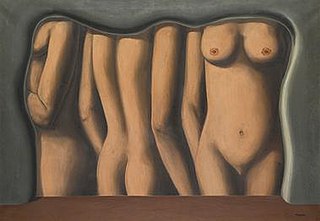 W
WThe Adulation of Space is a painting in oil on canvas, 81 × 116 cm, created between 1927–28 by Belgian surrealist artist René Magritte. It is held in a private collection.
 W
WApparatus and Hand is a 1927 painting by Salvador Dalí. The painting currently resides at the Salvador Dalí Museum in St. Petersburg, Florida. This work is on loan from the collection of Mr. and Mrs. A Reynolds Morse.
 W
WApparition of Face and Fruit Dish on a Beach (1938) is a painting by the Spanish surrealist Salvador Dalí.
 W
WAquis Submersus is a painting by the German dadaist and surrealist Max Ernst created in 1919. Influenced by the Italian metaphysical art it is one of Ernst's earliest works showing surrealistic accents. It currently resides at the Städel Museum in Frankfurt, Germany.
 W
WAt 4 O'Clock In The Summer, Hope, also known as About Four o'clock in the Summer, the Hope and At Four in the Summer, Hope, is a 1929 painting by French surrealist painter Yves Tanguy.
 W
WThe Barbarians is a 1937 painting by German surrealist painter Max Ernst.
 W
WThe Burning Giraffe (1937) is a painting by the Spanish surrealist Salvador Dalí. It is an oil painting on panel and is in the Kunstmuseum Basel.
 W
WCabaret Scene (1922) is a painting by the Spanish surrealist Salvador Dalí. It was a unique cubist experiment that came between Dalí's early impressionist work and the classic surrealist technique he would later develop. Dalí was inspired by Pablo Picasso after he got expelled from the School of Fine Arts in Spain. His inspiration was shown in his paintings, such as this one.
 W
WThe Colossus of Rhodes is a 1954 oil painting by the Spanish surrealist artist Salvador Dalí. It is one of a series of seven paintings created for the 1956 film Seven Wonders of the World, each depicting one of the eponymous wonders. The painting shows the Colossus of Rhodes, the ancient statue of the Greek titan-god of the sun, Helios. It was ultimately not used for the movie, and in 1981 was donated to the Kunstmuseum Bern, its present location.
 W
WThe Difficult Crossing (La traversée difficile) is the name given to two oil-on-canvas paintings by the Belgian surrealist René Magritte. The original version was completed in 1926 during Magritte's early prolific years of surrealism and is currently held in a private collection. A later version was completed in 1963 and is also held in a private collection.
 W
WElective Affinities is a 1933 painting by the Belgian surrealist René Magritte. The title is taken from Johann Wolfgang von Goethe's 1809 novel Elective Affinities.
 W
WThe Elephant Celebes is a 1921 painting by the German Dadaist and surrealist Max Ernst. It is among the most famous of Ernst's early surrealist works and "undoubtedly the first masterpiece of Surrealist painting in the de Chirico tradition." It combines the vivid dreamlike atmosphere of Surrealism with the collage aspects of Dada.
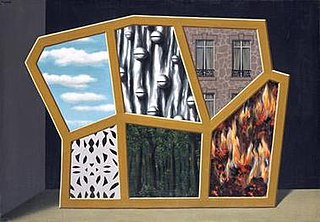 W
WThe Empty Mask (1928) is a painting by Belgian surrealist René Magritte.
 W
WThe Eye of Silence, 1943–44, is a painting by German dadaist and surrealist Max Ernst.
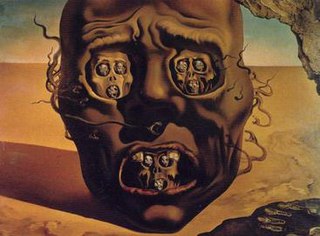 W
WThe Face of War (1940) is a painting by the Spanish surrealist Salvador Dalí. It was painted during a brief period when the artist lived in California.
 W
WThe First Days of Spring (1929) is a painting by the Spanish surrealist Salvador Dalí. This is probably the most famous example of Dalí's early surrealist work.
 W
WFish Magic is a 1925 Surrealist painting by Swiss-German artist Paul Klee. The painting belonged to the collection of Walter and Louise Arensberg before being donated in 1950 to the Philadelphia Museum of Art where it is currently held.
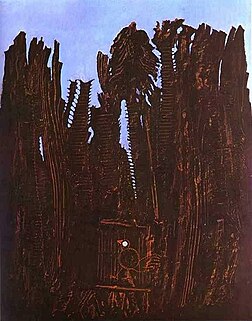 W
WForest and Dove (1927) is a painting by the German surrealist Max Ernst. It depicts a nocturnal scene of a forest of bizarre, abstract trees. In the thick of the forest is a childlike depiction of a dove.
 W
WThe Ghost of Vermeer of Delft Which Can Be Used As a Table is a small Surrealist oil painting by Salvador Dalí. Its full title is The Ghost of Vermeer of Delft Which Can Be Used as a Table . It makes reference to The Art of Painting by Johannes Vermeer, a famous seventeenth-century work in which a painter, thought to be a self-portrait of Vermeer, is depicted with his back to us, in distinctive costume. It is one of a number of paintings expressive of Dalí's enormous admiration for Vermeer.
 W
WThe Giantess is a painting by Leonora Carrington. The painting is considered one of her most famous works as it sold for almost $1.5 million in 2009. Carrington created The Giantess circa 1947 in Mexico City after becoming a resident of Mexico in 1942. The tempera on wood panel painting is 117 x 68 cm. The Giantess now resides in the private collection of Miguel S. Escobedo in Mexico.
 W
WGolconda is an oil painting on canvas by Belgian surrealist René Magritte, painted in 1953. It is usually housed at the Menil Collection in Houston, Texas.
 W
WThe Great Masturbator (1929) is a painting by Salvador Dalí executed during the surrealist epoch, and is currently displayed at Museo Nacional Centro de Arte Reina Sofía, Madrid.
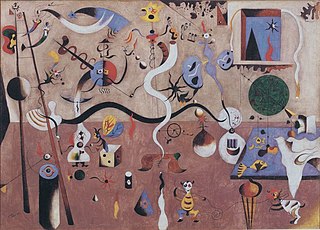 W
WThe Harlequin's Carnival is an oil painting rendered by Joan Miró between 1924 and 1925. It is one of the most outstanding surrealist paintings of the artist, and it is preserved in the Albright–Knox Art Gallery, Buffalo.
 W
WThe Human Condition generally refers to two similar oil on canvas paintings by the Belgian surrealist René Magritte. One was completed in 1933 and is in the collection of the National Gallery of Art in Washington DC. The other was completed in 1935 and is part of the Simon Spierer Collection in Geneva, Switzerland. A number of drawings of the same name exist as well, including one at the Cleveland Museum of Art.
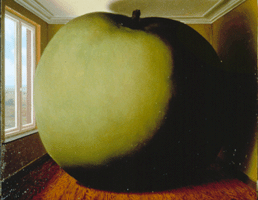 W
WThe Listening Room is an oil on canvas painting by the Belgian surrealist René Magritte which is currently part of the Menil Collection in Houston, Texas. A later version of the painting was made in 1958 and is held in a private collection.
 W
WThe Lugubrious Game is a part oil painting and part collage on cardboard artwork created by Salvador Dalí in 1929. It displays references to feces, sexual desire, castration and alludes to the "safety" of masturbation. The name of the painting was given by poet Paul Éluard.
 W
WMama, Papa is Wounded! is a 1927 oil-on-canvas painting by French surrealist painter Yves Tanguy.
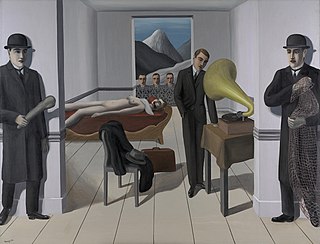 W
WThe Menaced Assassin is a 1927 oil on canvas painting by Belgian surrealist artist René Magritte.
 W
WMetamorphosis of Narcissus (1937) is an oil-on-canvas painting by the Spanish surrealist Salvador Dalí. Originally titled Métamorphose de Narcisse, this painting is from Dalí's paranoiac-critical period and depicts his interpretation of the Greek myth of Narcissus. Dalí began his painting in the spring of 1937 while in Zürs, in the Austrian Alps.
 W
WMorphological Echo is a title shared by two oil-on-panel paintings created by the Spanish surrealist Salvador Dalí.
 W
WThe Masterpiece or The Mysteries of the Horizon is a 1955 Surrealist oil painting by René Magritte.
 W
WNapoleon in the Wilderness is a 1941 surrealist painting by Max Ernst in the collection of the Museum of Modern Art in New York City.
 W
WOn The Contrary is an oil on canvas painting by Kay Sage, painted in 1952. It is housed in the Walker Art Center in Minneapolis, Minnesota.
 W
WOn the Threshold of Liberty refers to two oil on canvas paintings by the Belgian surrealist René Magritte. The work depicts a large room with the walls paneled with different scenes or windows. Each panel reveals a different subject: a sky, fire, wood, a forest, the front of a building, an ornamental pattern, a female torso and a strange metallic texture featuring spherical bells. Inside the room is a cannon.
 W
WPafama, short for Papierfarbenmalerei, is a 1922 painting by Croatian painter Josip Seissel. This painting is the first known abstract composition in Croatian art. It is currently in the collection of the Museum of Contemporary Art, Zagreb.
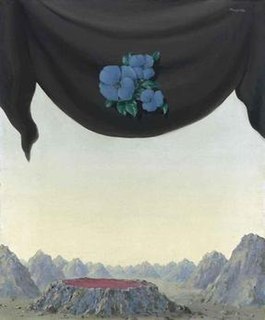 W
WThe Palace of Memories is a painting in oil on canvas, 46.2 × 38.2 cm, created in 1939 by Belgian surrealist artist René Magritte. It is held in a private collection.
 W
WThe Palace of the Windowed Rocks is a 1942 painting by French surrealist painter Yves Tanguy.
 W
WThe Persistence of Memory is a 1931 painting by artist Salvador Dalí and one of the most recognizable works of Surrealism. First shown at the Julien Levy Gallery in 1932, since 1934 the painting has been in the collection of the Museum of Modern Art (MoMA) in New York City, which received it from an anonymous donor. It is widely recognized and frequently referenced in popular culture, and sometimes referred to by more descriptive titles, such as "Melting Clocks", "The Soft Watches" or "The Melting Watches".
 W
WPietà or Revolution by Night (1923) is a painting by German surrealist and Dadaist Max Ernst. Since 1981 it has been part of the collection of the Tate Gallery in London.
 W
WThe Portrait (1935) is a painting by the Belgian surrealist René Magritte.
 W
WShirley Temple, The Youngest, Most Sacred Monster of the Cinema in Her Time, also known as the Barcelona Sphinx, is a 1939 artwork in gouache, pastel and collage on cardboard, by surrealist painter Salvador Dalí. It measures 75 cm × 100 cm. It is housed in the Netherlands, at Museum Boijmans Van Beuningen, Rotterdam's principal art gallery.
 W
WSleepwalker, "Somnambulist" is a painting from 1925 by Czech surrealist Jindřich Štyrský.
 W
WSoft Construction with Boiled Beans (1936) is a painting by the Spanish surrealist artist Salvador Dalí. Dalí created the piece to represent the horrors of the Spanish Civil War, having painted it only six months before the conflict began. He subsequently claimed that he was aware the war was going to occur long before it began, and cited his work as evidence of "the prophetic power of his subconscious mind." However, Dalí may have changed the name of the painting after the war to emphasize his prophetic assertions, although it is not entirely certain.
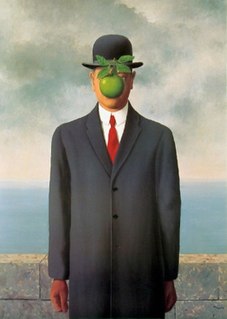 W
WThe Son of Man is a 1964 painting by the Belgian surrealist painter René Magritte. It is perhaps his most well-known artwork.
 W
WThe Song of Love is a painting by the Italian metaphysical painter Giorgio de Chirico. It is one of the most famous works by de Chirico and an early example of the surrealist style, though it was painted ten years before the movement was "founded" by André Breton in 1924.
 W
WSwans Reflecting Elephants (1937) is a painting by the Spanish surrealist Salvador Dalí. This painting is from Dalí's Paranoiac-critical period. Painted using oil on canvas, it contains one of Dalí's famous double images. The double images were a major part of Dalí's "paranoia-critical method", which he put forward in his 1935 essay "The Conquest of the Irrational". He explained his process as a "spontaneous method of irrational understanding based upon the interpretative critical association of delirious phenomena." Dalí used this method to bring forth the hallucinatory forms, double images and visual illusions that filled his paintings during the Thirties.
 W
WThe Tilled Field is a 1923–1924 oil-on-canvas painting by Catalan painter Joan Miró, depicting a stylised view of his family's farm at Mont-roig del Camp in Catalonia. The painting shows development from Miró's earlier works, such as The Farm, and is considered to be one of his first Surrealist works, created around the same time as the more abstracted Catalan Landscape . It is held by the Solomon R. Guggenheim Museum in New York.
 W
WTime Transfixed is a 1938 oil on canvas painting by the Belgian surrealist René Magritte. It is part of the permanent collection of the Art Institute of Chicago and is usually on display in the museum's new Modern Wing.
 W
WThe Voice of Space is an oil painting by René Magritte. Four oil versions exist of the image. The most famous is that held in the Solomon R. Guggenheim Foundation, Peggy Guggenheim Collection, Venice. Another publicly displayed version is held at the Albright-Knox Art Gallery, Buffalo, New York.
 W
WWhat the Water Gave Me is an oil painting by Frida Kahlo that was completed in 1938. It is sometimes referred to as What I Saw in the Water.
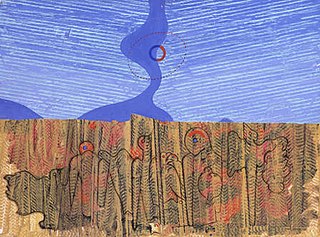 W
WThe Wood (1927) is a painting by the German surrealist Max Ernst.
 W
W W
W W
W W
W W
W W
W W
W W
W